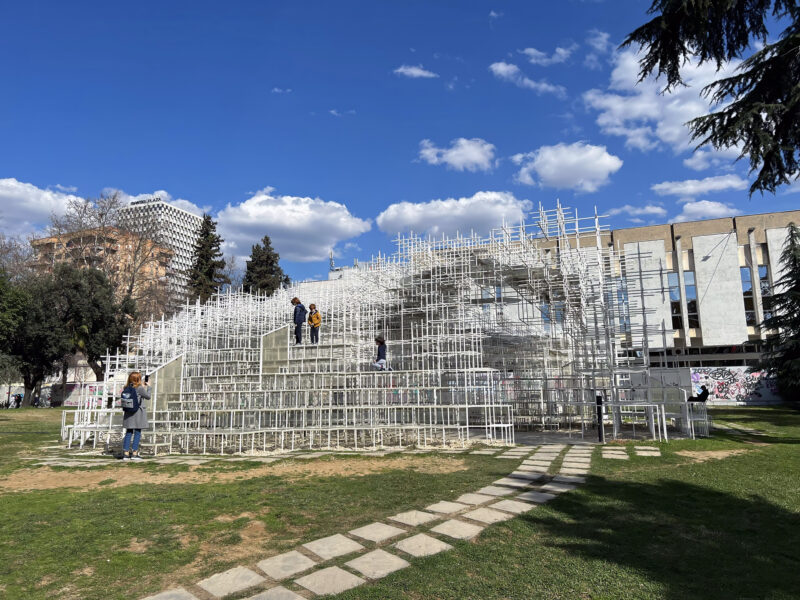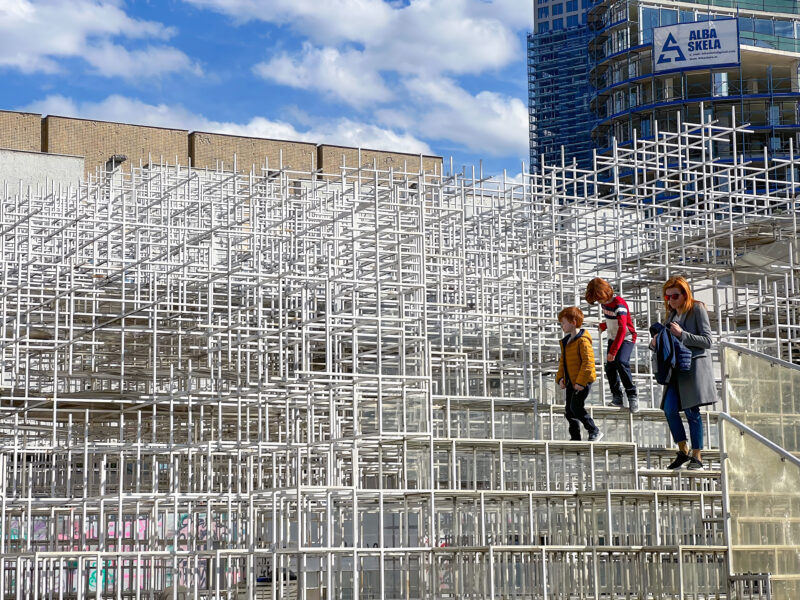
Bulevardi Dëshmorët e Kombit, Tirana Copy to clipboard
41.325523, 19.819764 Copy to clipboard
Best visit time
The Reja Cloud Pavilion can be visited anytime, but it’s particularly striking at sunset or nighttime when the lighting enhances its unique design.
Evening visits provide a more atmospheric experience, as the pavilion’s illumination transforms it into a glowing centerpiece.
If you’re looking for a quieter time, weekday mornings are ideal, but be aware that it might feel less captivating than its nighttime charm.
Introduction
Reja is one of the most popular public works installed in Albania 1. Reja was designed by well-known and celebrated Japanese 2 architect 3 Sou Fujimoto 4. It is now installed at Tirana at the Gallery of Arts. Tirana 5 was the second city to host the masterpiece after London 6 hosted it first 78.
Also commonly referred to as The Cloud, the construction is inspired by organic shapes that are naturally found in the environment. The artwork is highly accessible and interactive 9. It’s designed to be climbed and explored by visitors.

In this piece, the manufactured and natural combine to create a massive artificial nest. The delicate quality of the structure, enhanced by its opaque nature, is what helps to construct a geometric, massive cloud-like form that gives the illusion that mist or fog is rising from the ripples and waves of the park.
Fujimoto’s emphasized his focus on creating interactive and adaptable spaces in this statement 1011: “I like to think about architecture as a wider integration of things. I don’t want to divide landscape and architecture or cityscape and architecture [but instead] melt them together to provide a variety of fields for people to behave as they like.” He further explained:
I like to create a field for people to feel comfortable … One method we use is to divide the spaces into smaller pieces, then we can get different scales and have nice in-between experiences between landscape and architecture.
The structure
The nest was created using 20mm diameter steel bars that form an opaque, cloud-like design where visitors become an integral aspect of nature and the landscape while remaining protected within the structure. Each unit was made with fine steel bars measuring 800 and 400 mm, which were interconnected to create small rectangles.
Fujimoto’s design philosophy is deeply rooted in creating spaces that blur the boundaries between nature and architecture, encouraging diverse interactions. Fujimoto said 1213:
Nature and architecture are fundamental themes [of my work]. I like to find something in between. Not only nature and architecture but also inside and outside. Every kind of definition has an in-between space. Especially if the definitions are two opposites, then the in-between space is more rich.

In another interview 1415, Sou Fujimoto spoke about how he likes to create spaces that allow people to behave as they want, with an architecture that respects the diversity of people’s choices rather than dictating to them.
I don’t want to design a beautiful space…. I like to make a space in which people can be inspired by the space and by other people interacting within that space.
Public reception & controversies
The public has warmly received Reja (The Cloud), praising its innovative design and interactive nature. However, some critics argue that its modern aesthetics clash with the surrounding architecture. Despite this, it remains a beloved landmark and a focal point for cultural activities in Tirana.

Final words
The pavilion was made with two entrances. The pavilion contains a series of stepped terraces that provide seating areas for those visiting. Children and adults are allowed to climb to the top of the structure and take a seat underneath the city’s sky. Today, the Cloud is also frequently used for theatre and musical performances.
The artwork aligns with Albania’s efforts to modernize and promote contemporary art. It reflects the country’s cultural evolution and its desire to connect with global art trends. The installation serves as a meeting point for the community, fostering social interactions and cultural exchanges.
Reja (The Cloud) exemplifies a growing trend in architecture and art that emphasizes public engagement and interactive design. As cities continue to evolve, installations like this will likely become more common, blending art and functionality in public spaces.
The artwork holds significant cultural value both locally and globally. In Tirana, it symbolizes a new era of artistic expression and urban development. Globally, it represents Sou Fujimoto’s innovative approach to architecture and his ability to create spaces that resonate with diverse audiences.

Explore nearby
Tirana, Albania
 George W. Bush’s statue19 km away
George W. Bush’s statue19 km away Lee Bul's giant metal ZeppelinInstallation ended (dismantled in 2022)185 km away
Lee Bul's giant metal ZeppelinInstallation ended (dismantled in 2022)185 km away







